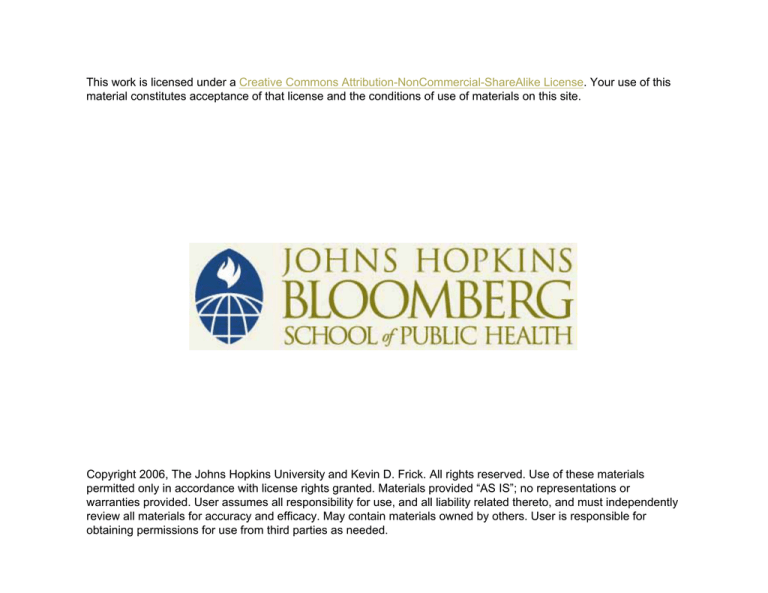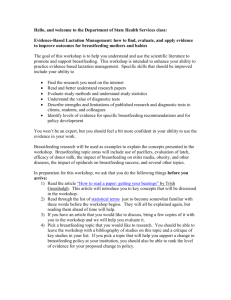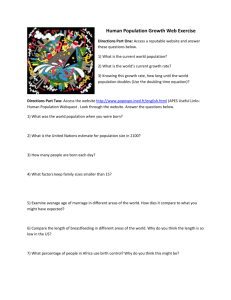
This work is licensed under a Creative Commons Attribution-NonCommercial-ShareAlike License. Your use of this
material constitutes acceptance of that license and the conditions of use of materials on this site.
Copyright 2006, The Johns Hopkins University and Kevin D. Frick. All rights reserved. Use of these materials
permitted only in accordance with license rights granted. Materials provided “AS IS”; no representations or
warranties provided. User assumes all responsibility for use, and all liability related thereto, and must independently
review all materials for accuracy and efficacy. May contain materials owned by others. User is responsible for
obtaining permissions for use from third parties as needed.
Methods of Evaluating
Food & Nutrition Policies:
How do we assess costs
in relation to effect and
benefit, and against
alternative programs
Kevin D. Frick, PhD
Department of Health Policy and Management
September 16, 2005
Outline
•
•
•
•
•
•
•
•
•
What is economics?
Where does CEA fit into research?
Definitions
What are we comparing?
Perspective
Measuring Benefits
Modeling
Examples
Present Value
Sensitivity Analyses
What is Economics
• “The study of how a society chooses to use its
limited resources (land, labor, and capital goods)
to produce, exchange, and consume goods and
services”
– Ruffin & Gregory 1988
• For economic evaluation of nutrition programs and
policy, we could look at how individuals make
decisions about nutrition in light of the incentives
they are given or we could use economic
reasoning to help us to evaluate the relative costs
and effects of a program
Where Economic Evaluation (CEA Specifically)
Fits Into Research & Policy Making
Measurement
of the
Effectiveness
of a Treatment,
Program, or
Intervention
Problem/
Potential
Solutions
Economic Reasoning & Results
Valuation
Time
Discounting
Inflation
Cost
Primary &
Secondary
Data
Incremental
CostEffectiveness
Ratio or
Net Benefit
Calculation
Choosing
Which
Program to
Fund or
Treatment to
Recommend
Frick, 2004
Definitions
Types of Cost Analyses
•
•
•
•
•
Cost Minimization
Cost Consequence
Cost Effectiveness
Cost Utility
Cost Benefit
Cost Minimization Analysis
• Two methods of achieving the same objective
– Determine which one costs less
• Examples
– WIC
• Guarantee that all breastfeeding mothers and
children in the US have sufficient caloric intake
– Healthy People-type
• Increase breastfeeding initiation to 90% of mothers
• Increase 6 months exclusive breastfeeding to 50% of
all mother-child dyads
– Ensure sufficient Vitamin A intake in a country
Cost Consequence Analysis
• Compare situation with and without intervention
– Describe the costs
– Describe the consequences
• Best when there is no primary outcome and it
would be difficult to produce a summary measure
of the outcomes
• Example
– Cost of program to increase breastfeeding
duration
• Changes in health outcomes for children, health
outcomes for mothers, and maternal-child bonding
Cost-Effectiveness
• Calculate ratio comparing change in costs with
change in effectiveness
–
Cost(New) – Cost(Old)
Effect(New) – Effect(Old)
– Interpret as extra money spent per extra unit of
outcome
• Best if there is only one effect or if there is clearly
a primary effect
Cost Utility Analysis
• Cost-effectiveness analysis with a particular type
of outcome
– Measures that can combine multiple types of
morbidity and mortality
• Multiple conditions and mortality risks associated with
obesity can be combined in one measure
• Quality adjusted life years (QALY)
• Disability adjusted life years (DALY)
– QALYs are more grounded in the theory of health
utilities
• Hear about “dollar spent per QALY gained” or
“dollar spent per DALY averted”
Cost-Benefit Analysis
• All benefits converted into dollars
– Some start as dollars but for others this is a complex
process
• Simplest cost-benefit analysis would be an analysis of costs
and cost-offsets
– Spend additional money to provide Vitamin A
supplements
– Save money by not needing to treat complications of
Vitamin A deficiency
– Compare costs averted with additional spending
• CBA has the unique ability to say whether a new program is
better than an old one (benefits are bigger than costs)
Simple CBA “Spreadsheet” Example
New Vitamin A
Program
Vitamin A Program
Program Costs
$0
$A
Costs of Treating
Vitamin A
Deficiency
$B
$C
If program is
effective, $C<$B
Total
$B
$(A+C)
Empirical question
whether $A+C<$B
Definitions
Types of Costs
• Opportunity Cost
• Consumables
• Capital Goods
Opportunity Cost
• Economic concept of costs
• Technical definition is the value of the next best
use of resources
• In most cases, the market price is the same as the
opportunity cost
• However, there are some markets that do not
operate in a competitive way (e.g. donated
pharmaceuticals) and these often require
measures of cost other than what was spent
– Even the market for pharmaceuticals that are not
donated is not a perfectly competitive market
Consumable
• Items that are used only once or last less than a
one year
– The criterion of lasting less than one year is
relevant because costs are usually summed over
an annual time period
• Examples
– Vitamin A supplements
– Containers of formula
– Surplus food
• Mostly use actual price paid
Capital Goods
• Items that last for more than one year
• Lab equipment for blood testing
• Multiple ways to handle costs
– Could count entire cost in one year
• Sometimes paid for all at once
• Suggests no value at end of the year
• Not usually the choice in formal economic analysis
– Add depreciation and interest not earned because of
investment
• Difficult if it is government spending
• Depreciation in this sense is not necessarily the same as
accounting depreciation
• Consider re-sale or salvage value
What are we comparing?
• When have multiple programs, compare one with another
rather than comparing all to doing nothing
• The question that is asked is:
– If we want to spend more money than it costs for the
least expensive program, what is the extra cost of
achieving an extra unit of outcome?
• Looking at the next leas expensive program
• In contrast, what would it cost to achieve other outcomes
using the money for some alternative intervention?
– If we have even more resources available, what is the
extra cost per extra outcome gained to move to the next
higher spending level? (This can be repeated)
Graph Showing What We Are Comparing
# of Target
Individuals
With Proper
Nutrition
Cost of Differently Structured
Nutrition Supplementation Programs
What is a “good buy”?
• If outcome is not a life year, DALY, or QALY, the
definition of a “good buy” is arbitrary
– Is it worth $1 per child to give an annual Vitamin A
supplement?
• How about $10, $100, or $1000?
• Can compare with the cost-effectiveness of
established programs
– However, it is not necessarily clear that these are
good buys
• Rule of thumb says less than $50,000/QALY
gained in the US
• Rule of thumb says less than 3xGDP per capita
per DALY averted in the world
Perspective
• Whose costs and whose benefits matter
• Government
– Which level?
– Which agency?
• Employer
• Societal
– Recommended
– Often difficult
– Not always what decision makers are actually
concerned about
Example of Differences in Perspective
• Breastfeeding promotion program
– Community health nurse & peer counselor
– Who pays and who benefits
• Local public health agency might fund it
• Managed care organization might fund it
• Short-term benefits may accrue to child and mother
– May lead to savings for Medicaid or a private insurer
• Long-term benefits may accrue to child and mother
– Not clear who will benefit monetarily other than family
• Could also have affects on workplace, family, and others in
society
– Key is that costs and benefits do not accrue to the same
parties in society
Another Example
of Importance of Perspective
• Reported in: J Urban Health, 81(1): 106-118
• Study in which older adults were randomized to
participate in a 15 hour per week volunteer activity
or not and public elementary schools were
randomized to receive volunteers or not
– Who funds program
• Includes stipend for older adults
• Local school district
• Federal AmeriCorps program
– Who benefits
• Medicare, Medicaid, school district, juvenile justice,
students and families
Measuring Benefits
• Dollars saved or expenditures avoided
• Ask individuals how much they value health outcomes
• Use productivity measures for people who are able to
continue work or to go back to work rather than being
disabled
• Quality adjusted life years
– Ask individual questions from a questionnaire over time
and score the combination of quantity and quality of life
• Disability adjusted life years
– Note condition over time and calculate disability
adjusted life years combining time in condition and
mortality from condition data
– Try to avert rather than gain DALYs
Benefits Measures for Breastfeeding
•
•
•
•
•
•
Dollar value of changes in sleep patterns
Dollar value of changes in feeding time
Dollar value of less need to buy formula
Dollar value of different use of diapers
Dollar value of reduced health care utilization
Quality adjusted life years gained from avoiding
breast cancer
Valuing Benefits
of Vitamin A Supplementation
• Productivity associated with less xerophthalmia
– DALY measure as well
– Affects those who are deficient in vitamin A
• Productivity associated with less diarrhea
– Affects those who are deficient and whose who
care for those who are deficient
• Decreased medical care costs associated with
both conditions
• Others…
Valuing Benefits in
the Older Adult Volunteer Program
Decreased medical care costs for Medicare
Decreased medical care costs for Medicaid
Quality adjusted life year improvement
Value of children being high school graduates
rather than not
• Unable to value changes in time principal spent on
discipline, changes in teacher retention, changes
in community value of school
•
•
•
•
Modeling
• Think about where data come from
• Gold standard to show efficacy is the randomized trial
• However, many health interventions may not go beyond a
“process” measure of effect
– How many people got _______....?
• How do we take the result further than “How many people
got _______....?”
– Modeling
– Easier to do in some fields than others
– Consider health communication programs
• Can we move beyond changes in behavior
• Accepted as a part of many cost-effectiveness studies
– Often in combination with primary data collection
Why might we need modeling?
• Have only limited resources to collect outcome data
• In spite of thinking there are sufficient resources to collect
outcome data, cannot do so
• Collected only intermediate outcome data
• Have other data available from clinical trials, other
epidemiological studies, even white papers that provides
probabilities of events or costs that would occur after your
data collection ended
• Example
– If we supply Vitamin A to 100,000 children, how will it
change their outcomes for one year
• Use a large number either because have a large population
or because it helps to avoid discussion of “fractional”
individuals when modeling rare events
Modeling in a breastfeeding study
• We only followed children for 6 months
• We didn’t know exactly why they went to the
doctor or hospital
• We didn’t know exactly what type of formula was
bought for them
• We didn’t know the exact value of mothers’ time
• We couldn’t measure how it would affect
children’s obesity over a lifetime
• We couldn’t measure how it would affect mother’s
risk of breast cancer over a lifetime
Modeling in the
older adult volunteer study
• We collected data on self-reported health status
• We found other data that linked self-reported
health status with health care expenditures and
quality of life
• We assumed that findings from other data would
apply to our population
• We asked if it would be cost-effective to spend the
money for the program if the only benefit were for
the older adults’ health
• We then asked how many extra children would
need to graduate from high school to offset all
costs of the program
Study could be all modeling
• Suppose a program director was considering
multiple micronutrient supplementation
• Previous studies showing uptake of individual
supplements, cost of delivering individual
supplements, and effects of supplements
individually and in combination
• Want to consider multiple individual programs as
compared with a multiple micronutrient delivery
program
• Do we need a randomized trial?
• Do we need any type of study?
• How do we build a model?
Present Value
• Need a way to compare costs and benefits today with costs and
benefits that will occur 20 years from now
– Some nutrition policy has rather immediate effects
– Some nutrition policy will have affects for years
– Limiting or changing the type of calories a population takes in
will have effects that don’t necessarily show up until the future
• Present value
– Add up value of costs and benefits over time with different
weights depending on when costs and benefits occur
– Have option of applying same weight to all costs and all
benefits0—no discounting
– Generally hear about a discount rate of 3% which means that
costs and benefits 24 years from now are worth half of what
they are worth today
Life Experience Uses of Present Value
• Mortgage
– Present value is the amount handed over to the
seller on the day you buy the house
– However, because you are not paying it all at once
the total cash flow is higher than the present value
– There is a bigger gap between cash flow and the
present value when the interest rate is higher
• Retirement account
– If you retire with $1M in your account (the present
value), you will consume more if you leave some
in the bank to earn interest each year
Present Value and Breastfeeding
• Healthier baby in first year
– Do not need to adjust
• If breastfeeding affects development which has affects for
years to come
– Have to adjust future benefits (weight them lower than
present costs and benefits) in analysis
• Maternal risk of thrush while breastfeeding for 6 months
– Do not need to adjust
• Mother’s decreased risk of breast cancer
– Need to adjust expenses and QOL changes and
mortality changes associated with possibility of breast
cancer in the future to their present value
Present value and
older adult volunteer program
• Short-term changes in older adult health
– Do not adjust
• If we could demonstrate 5-10 year changes in
nursing home admission
– Adjust cost of nursing home stay to its present
value
• Children’s increased lifetime earnings that won’t
start for 15 years
– Adjust to present value
Present Value and Time Horizons
• A discussion of valuing improvements in the future
leads us to consider how far into the future
decision makers look
– No one correct answer
– CEA and CBA are supposed to try to trace all
relevant effects
• Decision makers may have a higher discount rate
(or a shorter time horizon) than society as a whole
• Does discounting and present value
considerations more generally disadvantage
prevention?
Sensitivity Analyses
• Make assumptions in modeling
– Is nutrition education being delivered by a
registered dietician or a community health worker?
• Affects price
• May affect outcome
• Make assumptions even if gather primary data
– For example, there might be multiple prices that
could be paid
• CHW could be paid or volunteer
– Want to know if the CHW being paid rather than
being a volunteer would make a difference in the
qualitative conclusion you draw
Sensitivity Analysis and Breastfeeding
• Different values of time spent bottle feeding the
child depending on whether mother or someone
else in the family is doing the breastfeeding
• Price of formula may be retail or wholesale and
the formula may be generic or name brand
• Amount paid for medical care may depend on
insurer
• Vary these one at a time to see if each choice in
the modeling process makes a difference in
whether the program is recommended
Multiple sensitivity analyses
• Can combine changes in multiple assumptions
• Example from some recent work on post partum
hemorrhage
– All combinations of assumptions led to same conclusion
• Multiple simultaneous assumption changes useful in this
case
– If the conclusion varied in no interpretable systematic
way, then the idea of multiple changes at once would
not be so useful
– If the conclusion changes in interpretable ways, this
tells you what where more information is needed to
make a more informed policy decision
Sensitivity Analysis and Simulation
• In addition to changing specific assumptions that
assign one value, an analyst can work with ranges
of values and probabilities of different parts of the
range occurring
• Draw a number at random over and over again
and see what happens
– Do you always reach the same qualitative
conclusion?
– How often do you reach the same conclusion?
– Is there too much uncertainty to make policy?
Simulation Results
Using CEA
• Economics adds information but does not make the decision
• Economics provides an explicit and transparent way to place
a value on effects that may vary
• Economics emphasizes that we are comparing programs to
each other (in terms of cost and effect) and not always to no
program
– While it may seem like we are spending few dollars per
outcome achieved for a more expensive intervention, if
you can get most of the benefits by spending a fraction
of the money, it may be better for society to spend less
money on the program in question and the remainder of
the money on some other health improvement program
Summary with
Breastfeeding CEA as an Exemplar
• Can gather primary data or model or both
– Study breastfeeding intervention in a community but
add data as necessary from outside sources to develop
a model that is creative but credible
• Need a method for valuing benefits
• Consider relative value of short term and long-term benefits
• Need to comment on who is spending and who is saving
– There is a fuss about the breastfeeding promotion
program because someone feels they are losing
• Use results to inform policy making process
– Economics doesn’t consider ethics or distributional
issues




